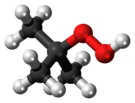tert-Butyl hydroperoxide
| |||
| Names | |||
|---|---|---|---|
| Preferred IUPAC name
2-Methylpropane-2-peroxol[1] | |||
| Systematic IUPAC name
tert-Butyl hydroperoxide | |||
| Identifiers | |||
| 75-91-2 | |||
| 3D model (Jmol) | Interactive image | ||
| Abbreviations | TBHP | ||
| 1098280 | |||
| ChEMBL | ChEMBL348399 | ||
| ChemSpider | 6170 | ||
| ECHA InfoCard | 100.000.833 | ||
| EC Number | 200-915-7 | ||
| MeSH | tert-Butylhydroperoxide | ||
| PubChem | 6410 | ||
| RTECS number | EQ4900000 | ||
| UNII | 955VYL842B | ||
| UN number | 3109 | ||
| |||
| |||
| Properties | |||
| C4H10O2 | |||
| Molar mass | 90.12 g·mol−1 | ||
| Appearance | Colorless liquid | ||
| Density | 0.935 g/mL | ||
| Melting point | −3 °C (27 °F; 270 K) | ||
| Boiling point | 37 °C (99 °F; 310 K) at 2.0 kPa | ||
| miscible | |||
| log P | 1.23 | ||
| Acidity (pKa) | 12.69 | ||
| Basicity (pKb) | 1.31 | ||
| Refractive index (nD) |
1.3870 | ||
| Thermochemistry | |||
| Std enthalpy of formation (ΔfH |
−294±5 kJ/mol | ||
| Std enthalpy of combustion (ΔcH |
2.710±0.005 MJ/mol | ||
| Hazards | |||
| Safety data sheet | |||
| GHS pictograms | 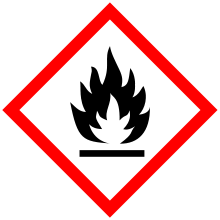 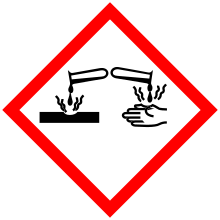 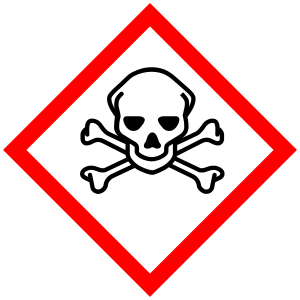 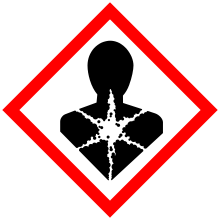 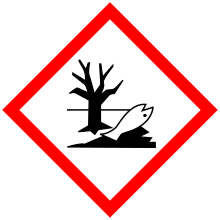 | ||
| GHS signal word | DANGER | ||
| H226, H242, H302, H311, H314, H317, H331, H341, H411 | |||
| P220, P261, P273, P280, P305+351+338, P310 | |||
| EU classification (DSD) |
| ||
| R-phrases | R7, R10, R20/21/22, R34, R43 R52/53 | ||
| S-phrases | S3/7, S14, S16, S17, S24, S36/37/39, S45, S61 | ||
| NFPA 704 | |||
| Flash point | 43 °C (109 °F; 316 K) | ||
| Except where otherwise noted, data are given for materials in their standard state (at 25 °C [77 °F], 100 kPa). | |||
| | |||
| Infobox references | |||
tert-Butyl hydroperoxide (tBuOOH) is an organic peroxide widely used in a variety of oxidation processes, for example Sharpless epoxidation.[3] It is normally supplied as a 69–70% aqueous solution.
Application
Industrially, tert-butyl hydroperoxide is used as a radical polymerization initiator.
Synthesis and production
Many synthetic routes are available, including:[4]
- Reaction of hydrogen peroxide with isobutylene or tert-butyl alcohol in the presence of sulfuric acid
- Reaction between tert-butyl alcohol and peroxymonosulfuric acid (however, an explosive intermediate is formed in this reaction)
- Auto-oxidation of isobutylene with oxygen
Safety
tert-butyl hydroperoxide is an exceptionally dangerous chemical that is highly reactive, flammable and toxic. It is corrosive to skin and mucous membranes and causes respiratory distress when inhaled. [5]
A solution of tert-butyl hydroperoxide and water with a concentration of greater than 90% is forbidden to be shipped according to US Department of Transportation Hazardous Materials Table 49 CFR 172.101.
In some sources it also has an NFPA 704 rating of 4 for health, 4 for flammability, 4 for reactivity and is a potent oxidant,[6] however other sources claim lower ratings of 3-2-2 or 1-4-4.[7][8]
See also
References
- ↑ "IUPAC Complete Draft 2004" (PDF).
- ↑ Cameo Chemicals, reference for NFPA values.
- ↑ tert-butyl hydroperoxide at Organic Chemistry Portal
- ↑ Jose Sanchez; Terry N. Myers. "Peroxides and Peroxide Compounds, Organic Peroxides". Kirk‑Othmer Encyclopedia of Chemical Technology. Wiley-VCH Verlag GmbH & Co. doi:10.1002/0471238961.1518070119011403.a01.
- ↑ Sigma Aldrich MSDS
- ↑ "TERT-BUTYL HYDROPEROXIDE" at CAMEO Chemicals NOAA
- ↑ tert-BUTYL HYDROPEROXIDE at Chemicalland21
- ↑ tert-Butyl hydroperoxide at http://environmentalchemistry.com

